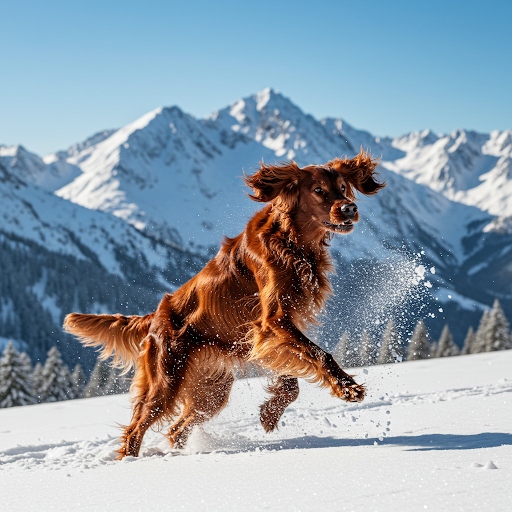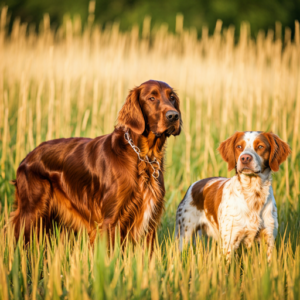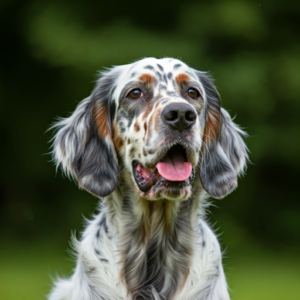The Irish Setter’s origins as a hunting dog can be traced back to the 18th century in Ireland, where the breed was primarily developed for bird hunting. This breed, with its iconic red coat, was specifically bred to perform crucial roles in the field, including pointing and retrieving. Over time, these traits were carefully honed, making the Irish Setter one of the most valued companions for bird hunters.
Table of Contents
The Irish Setter hunting history reveals how the breed was perfected through a combination of Spaniel, Pointer, and Setter breeds to enhance the dog’s natural abilities, resulting in a versatile and efficient hunting companion.

1. Introduction to the Irish Setter as a Hunting Dog
1.2 The Role of the Irish Setter in Traditional Hunting
In traditional hunting practices, the Irish Setter was prized for its ability to point and retrieve game. Upon locating a bird, the Setter would freeze in place, signaling the hunter to take the shot. Once the bird was downed, the Setter would fetch it gently and return it to the hunter without damaging the game. This level of precision and dedication to the task made the Irish Setter indispensable to hunters in the 18th and 19th centuries.
The breed’s endurance and agility were also valuable for navigating difficult terrains, from dense underbrush to expansive open fields, further enhancing its role in both upland bird and waterfowl hunting, as seen in the Irish Setter hunting history.
2. The Evolution of the Irish Setter in Hunting
2.1 Early Breeding and Selection for Hunting Skills
The early breeding of the Irish Setter focused on enhancing its hunting attributes. Breeders selected for essential traits such as excellent sight, an acute sense of smell, and superior endurance. These qualities ensured that the Irish Setter could cover vast distances, maintain focus, and retrieve game efficiently, making it a prime candidate for both competitive and practical hunting scenarios.
The Irish Setter hunting history showcases how early breeders carefully shaped the breed’s abilities to excel in diverse environments, preparing the Setter for different terrains, from wetlands to rugged highlands.
2.2 The Growth of the Irish Setter’s Reputation
As the Irish Setter continued to demonstrate its hunting proficiency, its reputation spread beyond Ireland. Its striking red coat and impressive skillset led to growing popularity, both as a working dog and as a show dog in the 19th century.
The breed’s Irish Setter hunting history further solidified its status, with hunters and dog enthusiasts recognizing its versatility in the field. This growing reputation made the Setter a popular choice for hunters across Europe and North America, ensuring the breed’s continued prominence in the hunting world.
3. Key Characteristics of the Irish Setter as a Hunting Dog
3.1 Physical Traits for Effective Hunting
The Irish Setter is known for its athletic build and sleek frame, making it highly suited for hunting. With long, muscular legs and a well-proportioned body, it is built for speed and stamina, capable of covering extensive ground during a hunt.
The Irish Setter hunting history reveals how the breed’s tall stature and flowing coat not only contribute to its graceful appearance but also protect it from the harsh elements, such as thorns and rough terrain, ensuring it can handle a long day of work in the field.
3.2 The Irish Setter’s Instincts and Intelligence
The Irish Setter’s natural instincts, developed through centuries of hunting history, are a key reason it excels in the field. Its ability to point at birds and retrieve them with precision is an inherent trait that has been passed down through generations.
In addition to these instincts, the breed’s intelligence allows it to learn commands quickly and adapt to various hunting conditions. The Irish Setter hunting history emphasizes how these qualities have made the Setter a reliable and versatile hunting companion, skilled in tasks ranging from scent detection to fieldwork.

4. The Irish Setter’s Role in Different Hunting Environments
4.1 Upland Game Bird Hunting with an Irish Setter
The Irish Setter is particularly adept at upland game bird hunting, especially when hunting pheasants, quail, and partridges. The breed’s agility, speed, and keen nose allow it to cover large fields, working tirelessly to locate and point at game.
Training the Irish Setter to perform in upland environments often involves exposing it to the scents and sounds of various birds. The Irish Setter hunting history demonstrates how this versatility allows the breed to thrive in open grasslands and fields, making it an essential tool for hunters in upland game bird hunts.
4.2 Waterfowl and Marshland Hunting
Irish Setters are not only effective in upland bird hunting but also excel in waterfowl hunting. Their natural affinity for water, coupled with their ability to swim efficiently, allows them to retrieve waterfowl from lakes and marshes with ease.
The breed’s stamina and agility in wet conditions make the Irish Setter invaluable to waterfowl hunters. The Irish Setter hunting history highlights how these qualities have made the breed a top choice for hunters in marshland environments, as the Setter seamlessly transitions between wet and dry terrain.
5. Irish Setter Training for Hunting
5.1 Early Training and Socialization
Training an Irish Setter for hunting begins early in life, with a focus on basic obedience, socialization, and exposure to hunting environments. Introducing a Setter puppy to various wildlife and outdoor settings builds its confidence and prepares it for the challenges of fieldwork.
Positive reinforcement and consistent practice are key in early training, ensuring that the Setter becomes familiar with essential hunting tasks. The Irish Setter hunting history demonstrates how early exposure to these tasks has shaped the breed into a reliable and obedient companion in the field.
5.2 Advanced Hunting Skills and Fieldwork
As the Setter matures, training should focus on more advanced skills such as scent tracking, pointing, and retrieving. Fieldwork plays a critical role in developing these abilities, and regular practice in real-world hunting environments is essential.
Training for stamina, focus, and endurance ensures the Setter can handle long hunting sessions and maintain performance in challenging conditions. The Irish Setter hunting history underscores the importance of refining these skills over time, as the breed’s natural instincts are sharpened and perfected for hunting.

6. Health and Maintenance for Hunting Irish Setters
6.1 Common Health Concerns in Hunting Dogs
Irish Setters, like all working dogs, may be prone to certain health issues due to the physical demands of their job. Common conditions include hip dysplasia, elbow dysplasia, and progressive retinal atrophy. Regular checkups and a well-maintained diet are key in preventing these conditions from hindering the dog’s performance in the field.
Understanding the health challenges faced by hunting dogs, including the Irish Setter, is crucial for keeping them in optimal condition. The Irish Setter hunting history demonstrates how generations of careful breeding have worked to minimize genetic issues and maintain the breed’s health.
6.2 Keeping Your Setter Fit for Hunting Season
Maintaining the physical fitness of an Irish Setter is essential for success in the hunting field. Regular exercise, such as running, walking, and field training, helps keep the dog in peak physical condition.
Proper care of the Setter’s coat is also important for protecting it from environmental hazards such as thorns, mud, and water. The Irish Setter hunting history reflects the ongoing importance of keeping the dog in excellent condition, as it directly impacts its ability to perform during long hunting sessions.
7. The Irish Setter’s Contribution to Conservation and Ethical Hunting
7.1 The Role of Irish Setters in Sustainable Hunting Practices
Irish Setters have long played a role in supporting sustainable hunting practices by assisting hunters in locating and retrieving game without overhunting or harming bird populations. The breed’s contribution to ethical hunting is deeply connected to its Irish Setter hunting history, where it has been utilized as a partner in ensuring the balance of ecosystems remains intact.
Through their dedication to tracking and retrieving game with minimal disruption, Irish Setters have been integral to maintaining wildlife populations, making them an essential tool in responsible hunting practices.
7.2 Collaboration with Wildlife Experts and Conservationists
Irish Setters have also contributed to wildlife conservation efforts by working alongside wildlife biologists and conservationists. Their remarkable tracking skills have been used to monitor bird populations, track endangered species, and gather data for research on wildlife management.
In the context of the Irish Setter hunting history, the breed has been instrumental in conservation programs, where its natural abilities have been harnessed to help preserve habitats and ensure sustainable hunting practices. Hunters often collaborate with experts, using their Irish Setters to assist in fieldwork and monitoring efforts that support the health and longevity of wildlife populations.

8. The Irish Setter in Hunting Competitions and Field Trials
8.1 History of Irish Setters in Field Trials
Field trials have long been a vital part of the Irish Setter’s history, showcasing the breed’s hunting prowess in competitive settings. These trials evaluate a dog’s pointing, retrieving, and overall performance in hunting scenarios. The Irish Setter hunting history is rich with accounts of successful Irish Setters in these competitions, where they demonstrated their exceptional skills and versatility.
Irish Setters quickly gained recognition for their speed, agility, and natural instincts during field trials, helping solidify their reputation as one of the top hunting breeds. Their strong performance in these events has helped ensure their continued popularity in the hunting world.
8.2 Preparing for and Competing in Dog Trials
Training an Irish Setter for field trials involves refining its skills, including pointing, retrieving, and responding to hunting commands with precision. Competitors must ensure their dogs are conditioned for the physical demands of the trial, which often include long runs and complex fieldwork.
Understanding the judging criteria, which often focus on the dog’s ability to locate and retrieve game, is essential for training. The Irish Setter hunting history reflects how the breed’s natural talents were further honed and showcased in trials, where their performance has continued to set standards for hunting dogs.
9. Comparing the Irish Setter with Other Hunting Breeds
9.1 Irish Setter vs. English Setter: A Hunting Dog Showdown
While the Irish Setter and English Setter share a common ancestry, they have distinct differences that impact their hunting abilities. The Irish Setter is typically more energetic, with a faster pace and greater endurance, making it better suited for high-paced hunts in open fields. On the other hand, the English Setter tends to be more reserved and steady, often excelling in areas requiring careful movement and precision.
The Irish Setter hunting history highlights the breed’s high energy and speed as defining features that make it an ideal choice for hunters who require a fast-paced, agile dog that can cover large areas efficiently.
9.2 Irish Setters and Retrievers: A Versatile Comparison
Comparing the Irish Setter to Retrievers reveals both similarities and differences in their hunting roles. While Retrievers are known for their natural talent in bringing downed game back to the hunter, the Irish Setter is equally proficient in both pointing and retrieving. Its unique ability to cover ground quickly, locate game, and return it to the hunter makes it a versatile option for hunters looking for an all-in-one dog.
The Irish Setter hunting history shows how the breed’s versatility has made it an invaluable companion in the field, able to adapt to a variety of hunting environments, including both upland and waterfowl hunts.
10. The Future of the Irish Setter as a Hunting Dog
10.1 Maintaining the Legacy of the Irish Setter in Modern Hunting
The Irish Setter continues to thrive as a premier hunting dog, with its legacy as an exceptional bird dog firmly intact. Modern hunters continue to value the breed for its energy, intelligence, and natural abilities. Breeding programs and training techniques have evolved to ensure that Irish Setters remain at the top of their game, capable of excelling in a variety of hunting environments.
The Irish Setter hunting history has shaped the future of the breed, with a continued focus on improving stamina, responsiveness, and versatility, ensuring the breed’s place as a top choice for hunters for years to come.
10.2 The Ongoing Role of Irish Setters in Hunting Culture
Irish Setters have maintained a strong presence in hunting culture, with many hunters choosing the breed for its loyalty, enthusiasm, and outstanding field performance. As hunting practices evolve, the Irish Setter’s role in the field remains essential. The breed’s enduring popularity is a testament to its effectiveness and strong connection to traditional hunting methods.
As the Irish Setter hunting history demonstrates, the breed’s success is rooted in its continued ability to adapt to modern hunting needs, ensuring its legacy remains influential in the world of field sports and wildlife conservation.













